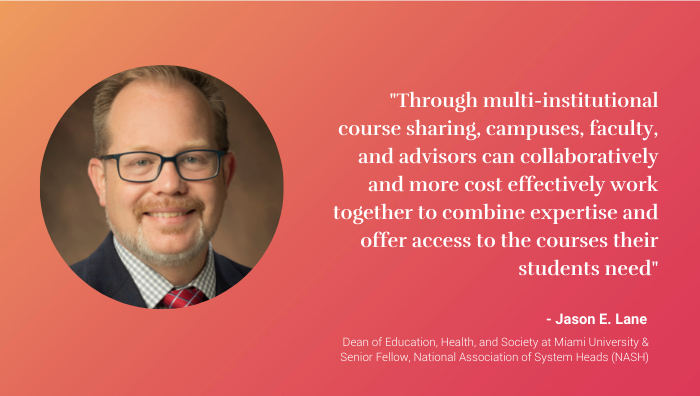Big Ideas for Improving Student Success
February 9, 2023

Originally published on Acadeum
A Focus on Collaborative Course Sharing as an example of “Systemness”
By Jason E. Lane, Dean of Education, Health, and Society at Miami University and Senior Fellow, National Association of System Heads (NASH)
To approach higher education from a student success perspective can be transformative–not only for students, but for the institutions supporting them. In an article published last year forThe EvoLLLution, I wrote about how higher education can lean into emerging ideas and technologies that facilitate cross-campus collaboration to improve student success. The fundamental focus was on how we shift our mindsets to think about the student at the center of the experience, as opposed to the institution. It isn’t just about the system or the institution; but the idea that, through collaboration of institutions, the sum of higher education’s value to students and society can be greater than its parts – or what I have come to call our “systemness.”
By training, I am a scholar of higher education governance and leadership and I’ve written and spoken broadly about the concept of systemness, including in my latest book Higher Education Systems Redesigned: Moving from Perpetuation to Innovation to Student Success. As a practitioner, I came to my current position as dean of Miami University’s College of Education, Health and Society having previously worked in the SUNY system—the largest comprehensive system of higher education in the country with 64 campuses and then around 450,000 students—including as vice provost and senior associate vice chancellor for academic planning and strategic leadership, where I led efforts to rethink ways we could more collaboratively work with and across campuses, share resources, and support students so they achieve their academic goals.
In this post, I wanted to take a moment to connect some of the big ideas I’ve written about previously with the exciting trends coming out of collaborative course sharing among institutions.
Combining Academic Expertise Across Campuses
The idea of “systemness”—institutions coming together collaboratively to leverage collective resources to add value to students and society— leads to anything from shared purchasing to shared courses.
Course sharing is an excellent way to illustrate the power of systemness. Historically, colleges and universities have assumed that all courses in a degree program need to be offered by the institution. There are very good arguments for this requirement, not the least of which being the need to make sure students can complete all degree requirements. Of course, we now see students (and their courses) swirling among institutions and it’s increasingly common for students to be taking courses at two institutions at the same time. And, we’ve all likely heard of students going to another college to pick up that one course that’s become an academic barrier at their home institution, often at a more convenient time, online, or at less cost. Yet, our policies and practices largely continue to reflect, if not reinforce, the primacy of organizing around the institution; rather than the student.
Today, advances in technology, inter-institutional policy alignment, and online learning make it possible for students to more seamlessly take courses from multiple institutions as part of their normal progression toward a degree (rather than having to be “transfer” students) and to have as part of the normal advising experience for students.
Through multi-institutional course sharing, campuses, faculty, and advisors can collaboratively and more cost effectively work together to combine expertise and offer access to the courses their students need. Institutions can think strategically about faculty utilization, growth opportunities, retention goals, and wraparound student support by leveraging courses available in their consortium. This sort of collaboration can occur through formal structures set up in higher education multi-campus systems or through collaborative consortia, such as through the Acadeum network.
Course sharing gives academic advisors a new tool in their tool belt to assist students and help them find course options seamlessly, when they need them most. When roadblocks appear on the path toward a degree–including poor performance in a course, missed pre-requisites, and personal challenges — the student doesn’t have to navigate the process of finding the courses and credits they need on their own. Systemness, especially as put into practice through course sharing (supplemented by staff development so there is broad knowledge about courses and programs offered across a system or consortium), is a powerful tool to expand high quality course access for students, across specializations and gen-ed options, so a single campus is not responsible for offering all courses, at all times.
Using Resources More Effectively: Beyond the Transfer System
The reality of higher education is that students move between institutions frequently, but too often, they cannot take their credits and progress toward a degree with them. Traditionally, when a student takes a transfer course, it slows time to degree and eats up financial aid — the typical student who tries to change colleges loses 43 percent of her credits.
In a recent report I co-authored for the National Association of System Heads, my colleagues and I identified a number of new approaches that systems of higher education are taking to improve transfer student success within the system. These efforts, among others, include policies mandating guaranteed transfer of credit and aligning curricular requirements across campuses. But, these efforts do not have to be the province of systems alone; similar efforts can be taken through collaborative, opt-in consortia where members agree in advance about who, when and how students can take courses across the consortium.
Instead, such consortia can help students plan a degree leveraging course sharing, where, in most circumstances, grades and credit hours transfer in easily and fully. With course sharing, students don’t have to wait an additional term for a needed course to be available at their institution but can take an approved course-sharing course at the time it is needed at a like-minded institution. The student’s home institution and its faculty maintain academic oversight and governance, and course sharing lets the student count both the credit hours and the grade at their home institution. Simple changes like these have the power to maximize the way that credits count and let students get the full value of what our institutions offer as well as their time, money, and effort, without leaving anything on the table.
Serving Students Better
As much as anything, systemness is about a mindset shift. I often like to pose to groups the following question: how do we stop asking why students are failing and instead ask how are we failing students? This simple shift in focus puts the onus on those of us in leadership roles to evaluate how our policies and practices might be hindering student success. How can we better help students succeed and get across the finish line? So much of this is dependent on having the right technology behind the scenes to simplify processes, ensure vetting and quality, and get students the support they need.
To put the student at the center of the educational experience means that we might also begin to push the envelope of academic programming in new ways. How do we move to offer students different on-ramps and off-ramps rather than just traditional 120-hour baccalaureate or 60-hour associate degrees? How can we develop new stackable credentials that offer students access to important and marketable and affordable skills in more manageable chunks? How can we get them the skills they need at the level of commitment they can manage? Last year, Market Scale predicted that “micro-credentialing will gain even more traction.” Students need fast, affordable, and flexible higher ed options they can turn around and use immediately in the workplace. We need a way to welcome students who may not want to commit to a full degree but need an entry point to get started on their educational journey. And what about the millions of people with some college and no degree? How can we help them achieve their goals in a more streamlined, convenient, and cost effective way?
This kind of outside-the-box thinking can unlock new educational opportunities for institutions and the students they serve.
With course sharing and other new technologies, we can reinvent higher ed in ways that better serve students, while also structuring and using resources more effectively. Being system-minded is an important step forward for higher education institutions. It is a valuable form of collaboration that will help us navigate future changes in the field and collectively build student success.
